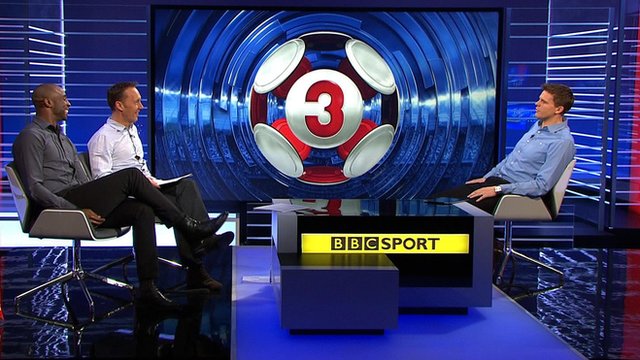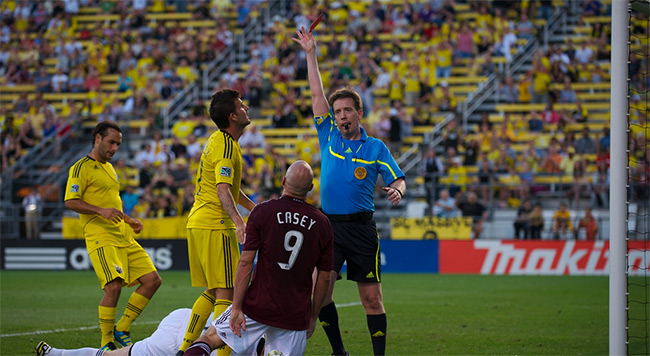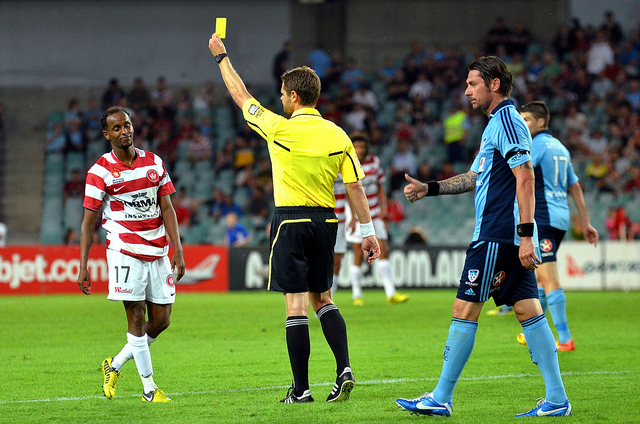
I should begin with a confession.
Like many British guys, I’m a huge fan of football (though I’ll call it soccer, just to make things easier) and although I support a premiership team which is so awful that my students routinely make fun of me for it, I watch at least one game on TV every weekend. I also ritualistically watch the BBC’s exceptional Saturday night highlights show, Match Of The Day.

And this got me thinking.
I became fascinated, not only with the game itself, but with its language. Soccer seems to have a special lexicon, like any sport, but more than that, when soccer is described and discussed, particularly by most experienced and gifted experts, it tends to draw out terrific metaphors, interesting historical references and meaningful cultural connections. For some time, I’ve wanted to compile some of this language, and teach a lesson or two specifically on soccer-based English. I’d like to present some of my findings, as well as methods for teaching and practicing these gems with your students.
One caveat: I do assume a very basic working knowledge of soccer. You don’t need to have memorized all the World Cup winners, and there won’t be a test at the end. Provided you know that the game involves teams of eleven people trying to put a ball in a net, we’re off to a good start. I’ll explain the rules of the game, highlighting useful and important language as we go.
6 Elements to Teach the Language of Soccer
-
1
The Players
This is essential vocabulary. For the British, one of the most mystifying aspects of American Football are the names of the positions, which correspond to nothing we’ve previously experienced; this leaves us even more confused as to what this large group of people are actually doing. So, help your students to quickly identify the roles of the players, thus:
- Goalkeeper (Keeper, Goalie).
- Defenders; central defenders are also called full backs; attack-minded left- and right-defenders can be called wing backs.
- Midfielders; they can be defensive or attacking, and a midfielder with special passing responsibilities is called the playmaker
- Wingers play on the extreme left and right of the midfield, and are generally trying to cross the ball to other players in the center.
- Forwards score the majority of the team’s goals. They’re also normally paid the most money. The most advanced forwards are called Strikers, whose sole job is to score goals.

There’s also the referee and two assistant referees (or referee’s assistants, depending on who you ask) who used to be called linesmen. Nowadays, there’s also the fourth official, whose tasks include advising the referee, organizing substitutions, and holding up the sign for additional minutes of playing time at the end of each half. He also gets routinely shouted at by the team coaches when referring decisions go against them.
-
2
General Language
The playing surface is called a pitch, rather than a ‘field’. Soccer fans talk about going to a match more often than going to a game, although both are possible. They will have favorite players from among the ‘team’, ‘squad’ or ‘side’, which has eleven players at all times (unless someone gets sent off), and up to seven substitutes, of which only three can be used during the game.
There are no time-outs. ‘Overtime’ is called ‘extra time’ and only happens during knock-out competitions like the FA Cup, the World Cup, and the final stages of the Champions’ League. Most matches are ‘league’ games, and teams are split into divisions of around 20 teams. The uppermost English division has been called the Premiership for about 20 years, with the second tier called the ‘Championship’. At the end of each season, three unfortunate teams are relegated from the bottom of each division into the division below, while the top three teams are promoted into the division above. For Premiership teams, being relegated is financially catastrophic, as they lose enormous amounts of TV and advertising revenue. Conversely, being promoted is a moment to savor and a sign that your club is headed for better things.
-
3
Time
With the exception of big international tournaments like the World Cup and European Championships, all competitions happen within a season. In Europe, this typically begins in August and runs all the way through to May. In each season, every club in a division will play every other club twice – home and away – so that in a twenty-club division like the Premiership, each team plays thirty-eight league games per season.
Matches all used to begin at 3pm on Saturday, but in our TV-dominated age, they begin at all manner of times, from lunchtime on Saturday through to the evening on Sunday.
Each half is forty-five minutes long. At the end of the half, the referee makes an independent decision as to how many stoppages there have been. The clock continues ticking, whatever happens, but he’ll total up the time spent dealing with injuries, restarting the game after fouls or goals, substitutions and the like, and instruct the fourth official to signal that number of additional minutes as the forty-five minutes comes to an end. Typically, there are no more than 3-5 minutes of stoppage time (also called injury time, but not extra time). Seven would be a lot, and would normally be the result of a lengthy injury or some other interruption, like an encroachment by fans, which used to have the far better label of pitch invasion.
In a knock-out game, if the score is tied at the end of ninety minutes, there will be two periods of extra time, lasting fifteen minutes each. If the score is still tied at the end of 120 minutes of play, the two teams must endure a penalty shoot-out. These are universally unpopular and highly stressful. Especially if you happen to be an England fan.
Twice a year, in January and again in the summer, there are transfer windows, during which it’s lawful for teams to inquire whether players from other teams might be tempted to transfer to another club. Huge sums in transfer fees are paid to bring players to the best clubs. Top players are then paid a lavish salary which, these days, is measured by the week, not the year; one reason for this is that a weekly salary for a soccer star is about the same as the annual salary for someone like you and me ($40,000 – $90,000, although perhaps twice as much for the very top players.) They are also paid bonuses for scoring a goal, keeping a clean sheet (a game where the team doesn’t concede a goal) or qualifying for the latter stages of knock-out competitions.
-
4
Game events
The game begins with the kick-off, with the team to begin with possession decided by a coin toss. Play only halts when there is a foul, the ball goes out of play (resulting either in a throw-in or a goal kick) or there is an injury or substitution.
One special foul is offside, (note the lack of a final ‘s’) which is famously hard to explain. Basically, an attacking player passes the ball forward when another attacking player has already proceeded beyond the line of the last defender. This is seen as cheating, because the most forward attacking player now has no obstacle between himself and the goal except the goalkeeper. Making decisions as to whether the attacker has in fact passed that final line is the referee’s assistant. They get it right perhaps 95% of the time.
Games are full of tackles. There will be several attempted tackles in each minute, as the team without ball struggles to regain possession. A tackle is judged to be unfair when the player fails to acquire or influence the ball, but kicks the opposing player instead; this is a foul, of which there will be a few dozen in each game.
Yellow cards are given for bad fouls, and there are normally several in each game. However, red cards are much less frequent, and are reserved for the most serious infractions. These include deliberately handling the ball to save a goal, or a situation where the last defender illegally tackles a player and therefore ‘prevents a clear goal-scoring opportunity’. Also included are dangerous, rash tackles such as ‘studs-up’ challenges or ‘diving in’ to challenge, which means the tackling player has jumped up and left the ground; these can break a leg and often result not only in a red card, but a suspension for three or more games.

Players can also be suspended for spitting at each other, violent conduct, off-the-ball incidents, tussling with members of the crowd (look up Eric Cantona for an example), biting other players (famously, the case of Luis Suarez – Google it if you don’t believe me) and, in a tiny number of memorable incidents, violence toward the referee.
-
5
The Poetry of Commentary
To illustrate just how colorful, vivid and pleasing the best soccer commentary can be, I’ve chosen a handful of particular situations and researched the language which can be used to describe them. From these examples, we can see the variety and richness of the language, and especially how much it relies on cultural references, many of which would be new to most ESL students.
This is highly idiomatic language, but I’ve found that these expressions can serve many functions which are quite unrelated to sport; football becomes the lens through which they are first seen, and provides a good example of their usage, before our students move on to independently use the same expressions in quite different areas.
- The Ups and Downs of a Game
The score is tied: We’re all square; it’s even Stevens; the score is level
Our team is behind: They’re facing an uphill struggle; they need to get themselves level; they need one of the strikers to get them out of jail; they’re working hard to get back on terms; it’s going to be a long afternoon / game / second half for the trailing team.
Our team risks going further behind: They’ve got their backs against the wall; they’re really up against it; they’re fighting a rearguard action; they’re fighting for their lives, now; they’re having the kitchen sink thrown at them; it’s all hands to the pumps / all hands on deck
Our team draws level: They’re back in it; we’ve got a real game on our hands now; they’re searching for the winner; they’re making a comeback
Our team finally goes ahead: They’ve completed the turnaround; they’ve turned the game (completely) on its head; they’ve stolen the points - A team being heavily defeated
They were:- Well / soundly / thoroughly beaten
- Embarrassed / humiliated
- Demolished / annihilated / thrashed / taken to pieces
- Thumped / left bruised / battered
- Put to the sword
- Chastened
- Brushed aside
- A coach delivering a half-team team talk
- The coach might have something to say about that at half time
- The team is going to get a telling off / ticking off / dressing down / stern talking to
- The coach is going to give them a piece of his mind / a lecture
- He’s going to get out the hairdryer at half time
- A game which is particularly exciting
- Don’t (whatever you do) take your eyes off this one
- It’s fabulous, end-to-end stuff
- Don’t get up to make a cup of tea
- This is spellbinding
- This is classic (FA Cup) action
- You can’t catch your breath
- Both teams are really going for it now
- Different types of passing
Good:- A perfect, slide-rule pass
- A lovely dinked ball into the penalty area
- A sweeping pass from deep
- A raking pass out of midfield
- A laser-guided pass forward
- A pinpoint accurate through-ball
- It’s crisp, one-touch passing
- It’s a perceptive cross-field ball
- A neat interchange / a quick one-two
- He got that one all wrong
- It was a careless / aimless pass
- He completely over-hit the pass / there was too much on the pass
- The attacker was always second favorite for that ball; it wasn’t accurate enough
- He fluffed his lines
- He misplaced the pass
- He sold his defender short
- Punishments
No card, but a lecture from the referee:- He’s going to get a telling off from the man in the middle
- It’s just a caution from the ref, no card as yet
- The referee wants a word with the offender
- He’s going to have his name taken here
- He’s going in the book
- That’ll be the first yellow of the game
- He’s on a yellow for the rest of the game
- That’s it, he’s gone.
- The referee had no option but to send him off
- He’s got to go. That was a horrendous challenge.
- He’s seen red.
- He’s received his marching orders.
- He’s being dismissed by the referee
- He’s being sent for an early bath
- They’re going down to ten men (for the remainder of the game)
- The Ups and Downs of a Game
-
6
Practicing The Idioms
Observing this language during matches is all well and good, but it would be even better for our students to put the language into practice. Here are some possible ways of doing just that:
- Your students watch part of a game, and write the script for a few minutes of commentary.
- Your students watch part of Match Of The Day, or a full game, and then continue their own commentary, with the sound muted
- Your students practice individual words or expressions in contextual sentences, in the same way they’d practice any new vocabulary
- Your students read a prepared passage which is packed with idioms, and then try to figure out what really happened
- Your students translate simple commentary into more colorful prose
I also like to give awards, or at least a hearty high-five, for students who manage to bring some of these expressions into their everyday English
Soccer is perhaps the most universally admired sporting activity, and a special class on its language will likely be very well received. I advertise the class as an incentive for good in-class behavior and the timely submission of homework, and it never fails.
Ideally, make the class a special elective, and have students prepare by watching some English-language commentary, so that they’ve already got a flavor of the language.
Working on the English of soccer will take some preparation, but your students will absolutely love it.
P.S. If you enjoyed this article, please help spread it by clicking one of those sharing buttons below. And if you are interested in more, you should follow our Facebook page where we share more about creative, non-boring ways to teach English.








